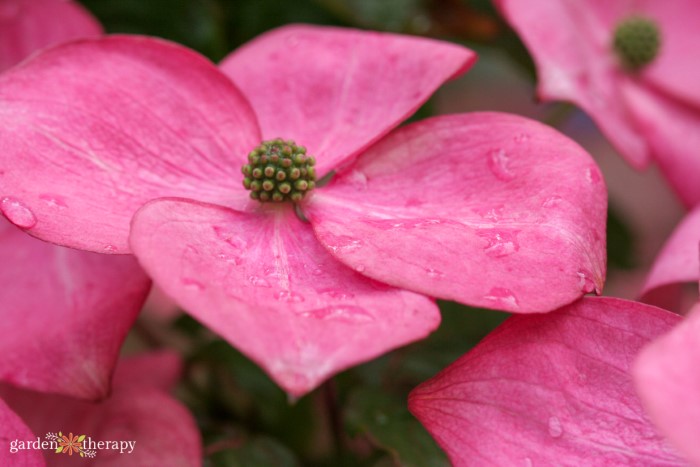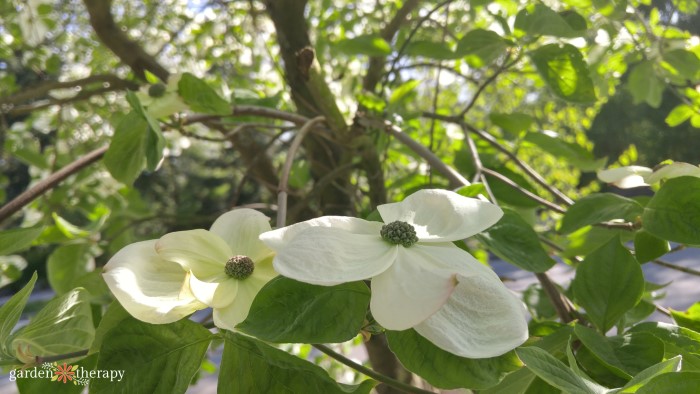A must-have for your woodland garden, the dogwood tree is a charmer. With so many varieties to choose from, you’re sure to be impressed by all the genus has to over. From shiny bright red berries for the birds to white spring blossoms for the bees, there’s plenty to love when it comes to adding a dogwood tree to your garden.

The mighty dogwood tree never fails to amaze me! I’ve long been a fan of this prolific grower. My first dogwood tree was a Japanese dogwood in the cultivar ‘Miss Satomi’. I planted it in the front yard of my first home. A dwarf variety, it provided a delightful burst of pink in the spring.
In my current home, I have a pacific dogwood. They’re very popular here in the pacific northwest as they thrive in this climate. They’re native here after all!
The white of the pacific dogwood really is a showstopper. When in bloom, the bracts go all the way up to the top of my house. And it’s a tall house.

With over 50 species in the Cornus genius known as dogwoods, there’s a little bit of something for everyone. Whether you want a small shrub or an evergreen tree, I’m positive you can find the ideal dogwood for your yard.
This post will cover…
- Meet the Dogwood
- Types of Dogwood Trees
- Planting a Dogwood Tree
- Caring for a Dogwood Tree
- Light
- Soil
- Water
- Fertilizer
- Pruning
- Pests and Diseases
- Frequently Asked Questions About Dogwood Trees
- More Posts to Read

Meet the Dogwood
Many dogwoods are known for their early spring flowers. Most people mistake the outer leaves (known as the bract) for the flower when really they are the little spots in the center. Amongst the most popular dogwoods is the flowering dogwood tree, which you can find cultivars of in various colours.
Most varieties produce berries in the summer. Over 30 species of birds are known to nibble on the berries, so they’re a great addition to the bird-friendly yard.

And once the blossoms, berries, and leaves have come and gone, you’ll be left with some beautiful bark to gaze at during the winter. From bright red to mottled gray, the bark of dogwood trees are known for their year-round eye candy.
First known as a dogtree, the name was derived from the word dagwood as the stems of the plant were used to make daggers and arrows. To this day, you’ll still find many items made of dogwood as it’s a very tough wood.
For centuries, people have been using dogwoods medicinally. The bark is known to be packed full of tannins. Ground bark or leaves have been used to treat pain, fever, wounds, incontinence, dizziness, and weakness.

Types of Dogwood Trees
There are SO many noteworthy dogwood trees, but here are some of the most common dogwood varieties you may encounter.
- Flowering Dogwood (Cornus florida): as the most popular type of dogwood tree, you can find blossoms in white, pink, and red. Blooming from May to June, they grow 20-25 ft high and wide and do well in zones 5-9.
- Red Twig Dogwood (Cornus sericea): the most common dogwood shrub, the red twig dogwood has white flowers in the spring, attractive foliage in the summer, and bright red bark for winter interest. Fairly cold hardy, it grows in zones 2-9 and reaches 6-8 ft high and wide.
- Cornelian Cherry Dogwood (Cornus Mas): one of the first trees to flower in the spring, this dogwood has yellow star-like flowers to brighten up the cold. In the summer, it has bright red berries and curling gray to brown bark in the winter. It grows 15-30 ft high, forming a thick shrub when left alone or a nice tree when trimmed.
- Japanese Dogwood (Cornus kousa): also known as the kousa dogwood, Korean dogwood, or Chinese dogwood, it can grow as a small deciduous tree or multi-stemmed shrub. The blooms are white/yellowish blossoms in the spring and pinkish red berries by fall with mottled bark noticeable in the winter. This variety blooms a month later than the standard dogwood.

Planting a Dogwood Tree
If you plan on adding a dogwood to your garden, they’re fairly easy to plant. First off, make sure to buy them from a reputable garden centre (rather than transplanting one from the wild) to avoid any fungal diseases.
Plant your dogwood tree in late spring. Warm weather kills viruses that thrive in cool, moist weather. You want to plant while the tree is dormant, with no visible growth yet, and when the soil is wet.
When planting, dig the hole extra wide to encourage the roots to grow outwards. Loosen the root ball with a soil knife to stop the plant from growing in the shape of the container it came in. Careful not to plant too deep.

Caring for a Dogwood Tree
Once you have your tree planted, make sure to keep your new dogwood in tip-top shape with the right care.
Light
Dogwoods prefer sunny areas that have some afternoon shade. They like to be protected from the sun either through dappled shade from a taller tree or partial shade from a nearby building.
Soil
Dogwoods are fairly adaptable when it comes to soil types, though they prefer it slightly acidic. Well-drained, moist soil is ideal though some may tolerate boggy conditions.

Water
The most maintenance a dogwood tree will need resolves around water. Since they have shallow roots, they dry out quickly. They do not like arid or semi-arid climates and are not drought tolerant. If you want a dogwood but don’t get much rainfall, irrigation or frequent watering is a must.
You will want to water regularly until it’s established. Water thoroughly until it reaches approximately 3 feet down. Look to the leaves to help determine watering needs. If crisp, they need more water. If droopy, it’s getting too much water.
Fertilizer
Dogwoods don’t require much fertilizer. If you have well-balanced soil, you may not need fertilizer at all. Most established shrubs and trees do not require fertilizer, so only apply it before it’s established.
A slow-release fertilizer at a ratio of 16-4-9 works best. Avoid overfertilizing as this can burn the leaves or even kill the plant.

Pruning
Lucky for you, dogwoods require very little pruning care! Like any plant, you can prune to remove any dead or diseased branches. You may also prune for shape, though most dogwood trees have a naturally good shape and don’t require pruning.
If you do prune, do so in late winter when the tree is dormant. Just be sure to prune before new leaves begin emerging in the spring.
Pests and Diseases
For dogwood trees, the most common disease is anthracnose, a fungus caused by Discula destructiva. This results in spotting of the leaf and twig dieback. You may also see powdery mildew, a whitish-gray powder on the leaves. Both can be prevented with good air circulation and by keeping foliage dry. Water at the base of your plant.
In terms of pests, you may notice your deer munching on young dogwoods. You may need to protect them when they’re young up until they’re big enough to be out of reach from hungry deer.
Another pest you may encounter is the dogwood borer. They burrow under the bark of the tree. To prevent them, avoid damage to the bark as that is how larvae enter. Never prune between April to June as that is when they’re active.

Frequently Asked Questions About Dogwood Trees
There are many varieties of dogwood trees, but flowering dogwoods are the most popular variety. Most often coated in white flowers in the spring, you can also find pink or red dogwood trees. In the summer, they get red berries known as drupes. In the fall, the leaves turn purple-red and the colourful stems and bark remain for the winter.
Most dogwoods can be identified by their leaves with smooth edges and veins that curve parallel to the edges. They also have opposite branching, where the side branches grow directly opposite of each other rather than alternating.
From shrubs to trees, plants under the Cornus genus can vary significantly in size. Most dogwood trees can grow up to 25 ft, with some being known to get as high as 40 ft. Dogwood shrubs typically grow 3-5 ft tall.
Dogwood trees grow at a medium rate. Every year you can expect them to grow 13-24 inches long, reaching full size in as little as a decade.
Many people know dogwoods for their strong fragrance. Some enjoy it while others hate it. But for most, it’s not unpleasant. The smell is notable when they’re flowering as the smell is used to attract insects and animals for pollination.

When it comes to the dogwood, you’ll certainly be barking up the right tree! Leave any of your dogwood questions below and I’ll get back to you as soon as I’m able.





Satomi, Rosabella, or Milky Way if you grow them in part shade will they grow faster or slower? In Illinois zone 5, I have been told they max out at 15’ . Which cultivar is likely to stay in the 10+ range?
Little Poncho kousa dogwood.
If a Dogwood did not shed all of its’ leaves last fall (they are grey and dry but still clinging), is the tree still healthy? My daughter bought a home with 3 Doqwoods in the backyard (in Brooklyn). They have an under soil watering system, but it was mistakenly turned off by the prior owners late last summer while the apartment was empty. The trees suffered from the extreme heat and lack of water. Is there a reason to worry?
Hi Deborah, drought like that can take out a dogwood. Time will tell if new leaves come out this spring.